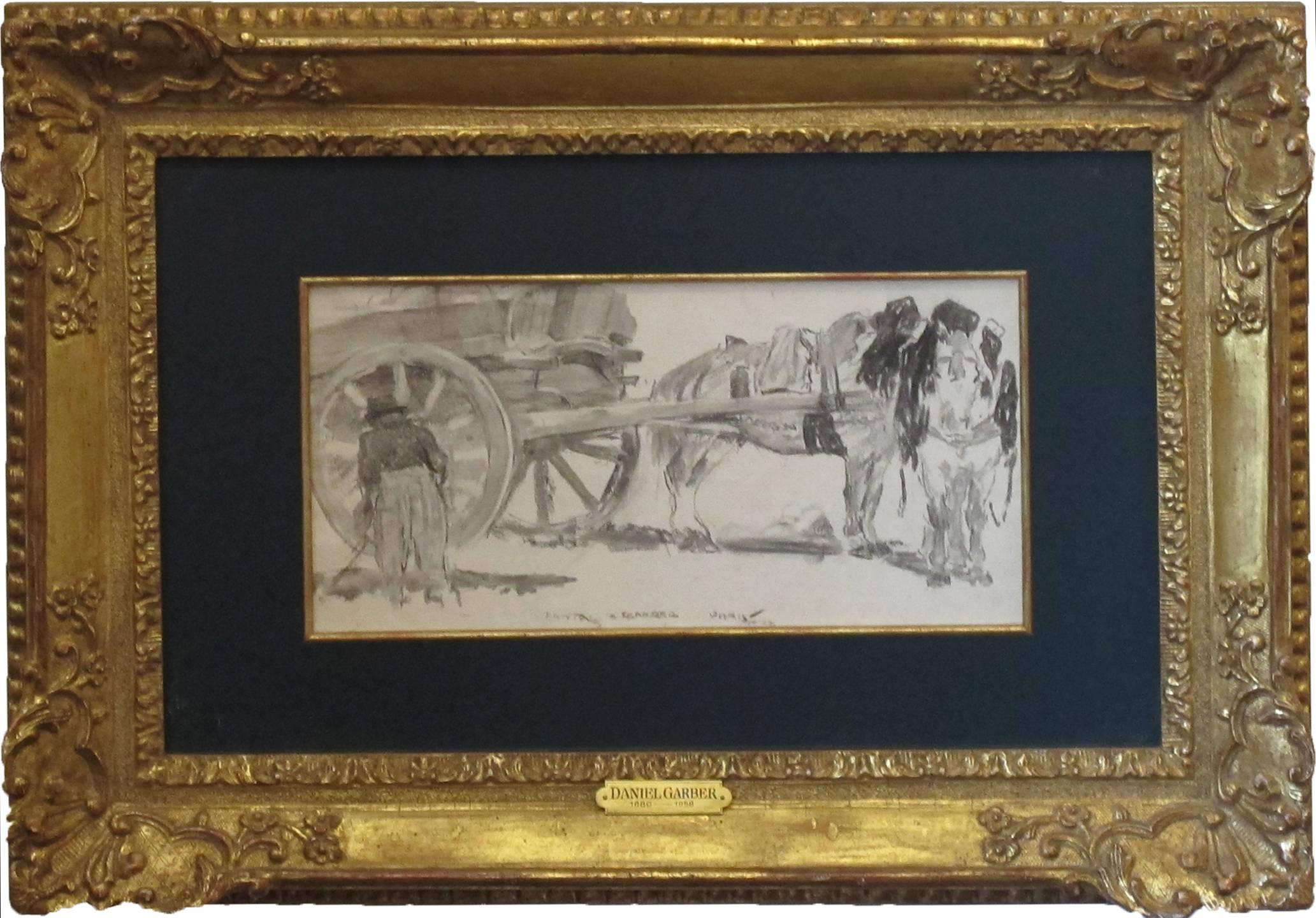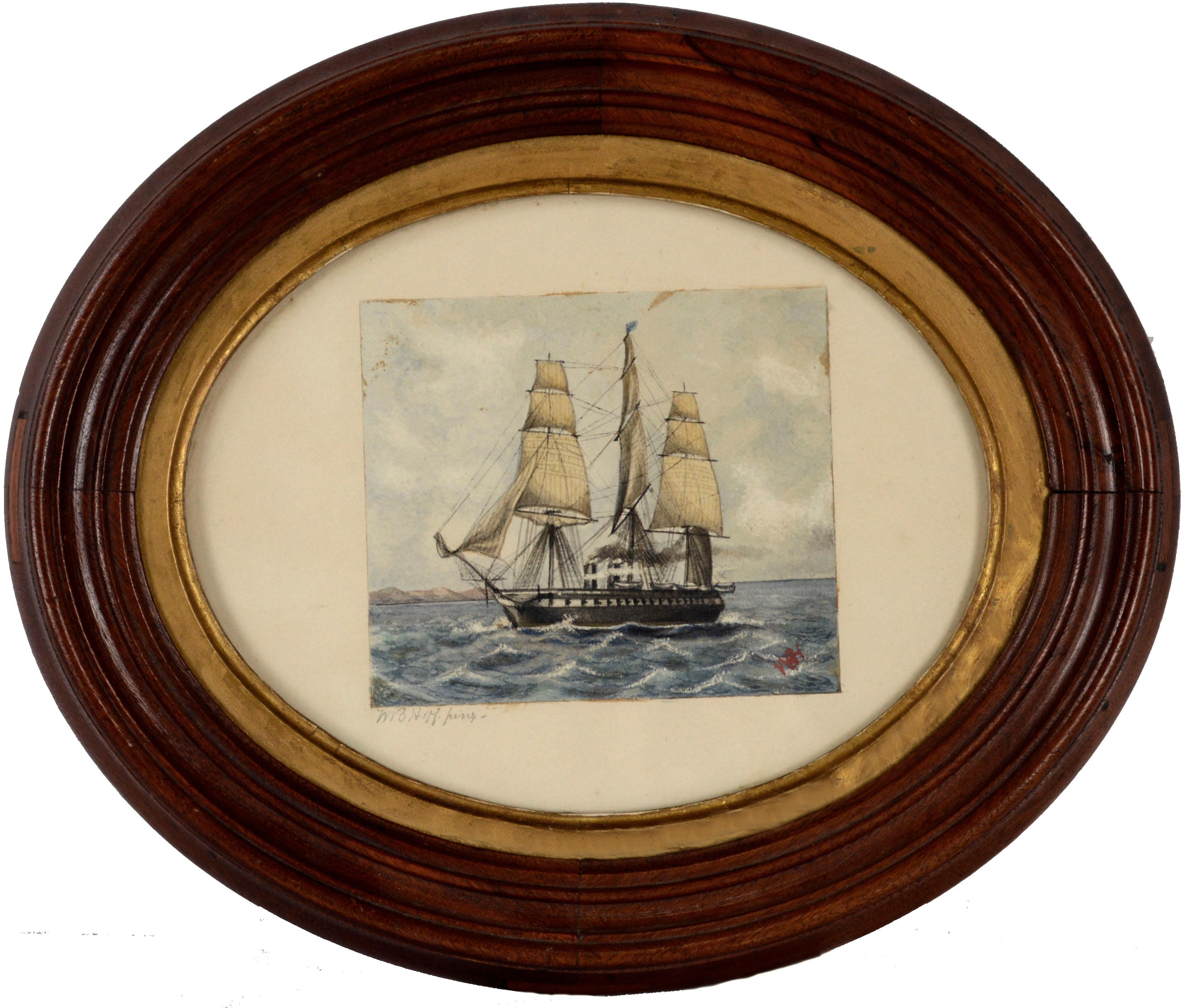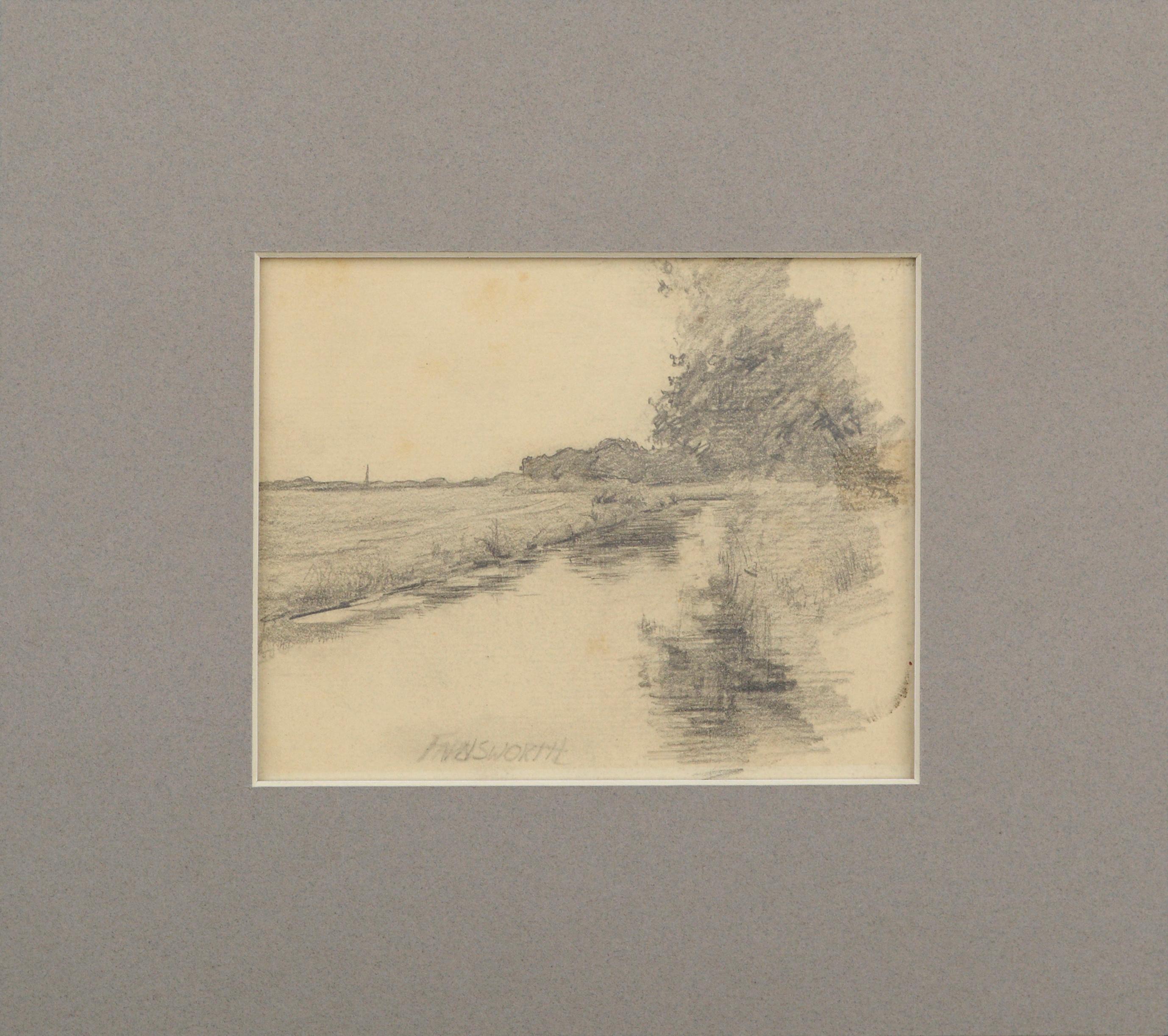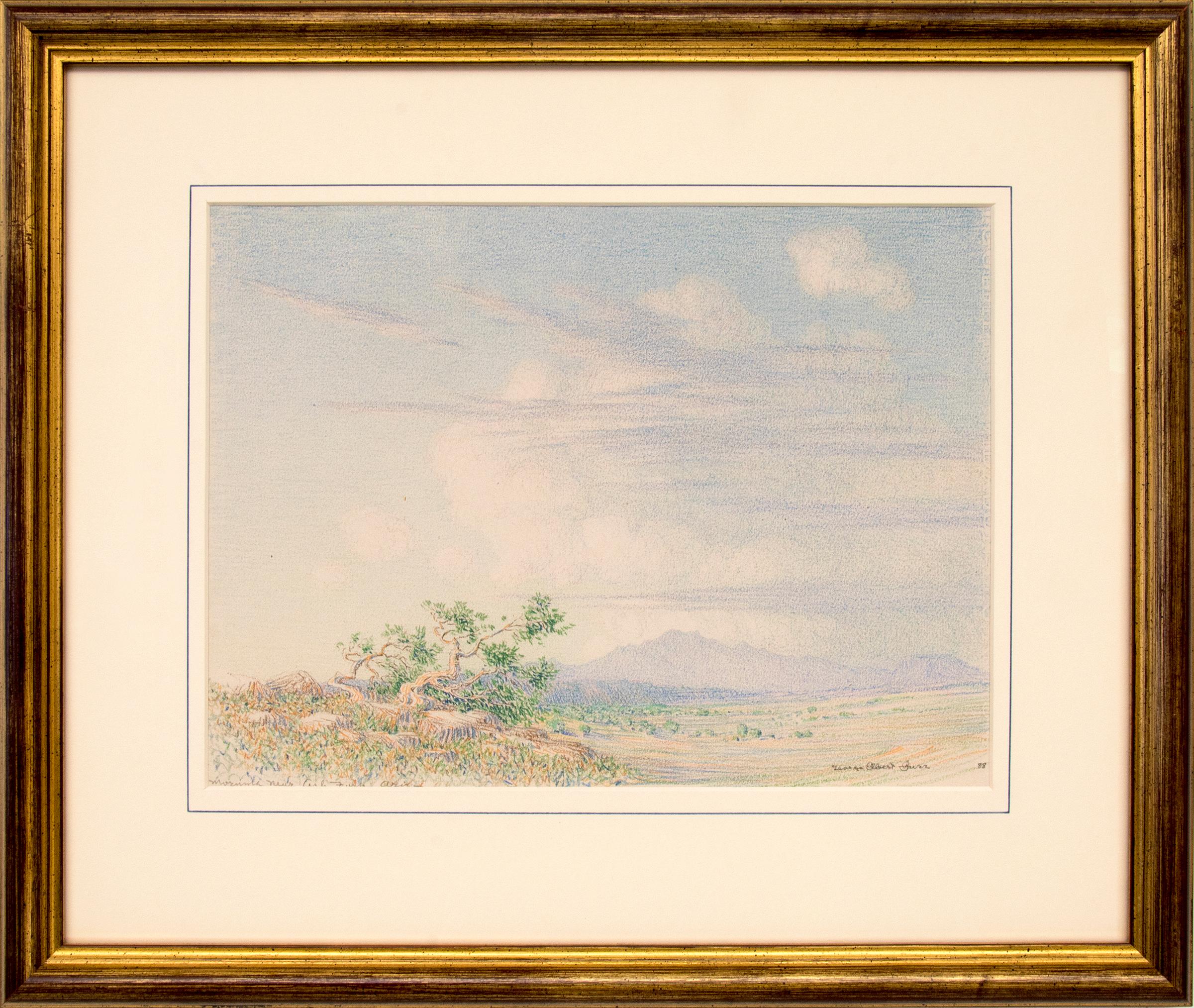Items Similar to Preliminary Drawing for the color aquatint "Street Gossip"
Want more images or videos?
Request additional images or videos from the seller
Louis Oscar GriffithPreliminary Drawing for the color aquatint "Street Gossip"1916-1917
1916-1917
About the Item
Preliminary Drawing for the color aquatint "Street Gossip"
Signed by the artist in pencil lower left
Graphite on tracing paper, 1916-1917
An impression of the color aquatint image (in reverse from this drawing) was sold at Neal Auction, Nov. 20-21, 2010, Lot 398. Provenance was the H. Lieber Company, Indianapolis with their label on the reverse. It was annotated "No. 11".
The aquatint "Street Gossip" is cited in Ann Dobie, "Louis Oscar Griffith" as being exhibited in Dallas at Highland Park Society of Arts.
Provenance:
Estate of the Artist
By decent
Born in Greencastle, Indiana, Griffith grew up in Dallas, Texas where Texas artist and teacher Charles Franklin Reaugh recognized young “Griff’s” artistic talent. At age 18, Griffith moved to St. Louis where he attended the St. Louis School of Fine Arts.
In 1895, he moved to Chicago where he worked making color prints for the firm Barnes and Crosby. He attended the Art Institute of Chicago and during a brief stay in New York, the National Academy of Design. A successful commercial artist with a studio in the Chicago Loop, Griffith was a member and president of the Chicago Palette and Chisel Club.
He made his first trip to Brown County, Indiana in 1908, intrigued by reports of beautiful scenery by other Chicago-area artists such as Adolph Shultz and woodblock print-maker Gustave Baumann.
Griffith’s first exhibition was in 1903 at the Art Institute of Chicago, which by 1824 exhibited more than 60 of his works. He showed almost 70 works at the annual Hoosier Salon Exhibition.
He won a bronze medal at the Panama-Pacific International Exposition in San Francisco in 1915; in 1921, he was a gold medalist at the Palette and Chisel Club; he won the Daughters of Indiana prize in 1925. The Chicago Society of Etchers recognized his works in 1949 and 1953; an oil, A Tranquil Afternoon, was awarded the Davis Wild Flower and Landscape prize in San Antonio, Texas.
The Smithsonian Institution in Washington mounted a special exhibit of Griffith’s prints in 1945. He also exhibited at the 1921 show of the Pennsylvania Academy of Fine Arts; the 1926 Sesquicentennial Exposition in Philadelphia; the 1927 second International Exhibition of Modern Engravings in Florence, Italy; the Canadian National Exposition; National Academy of Design in 1943; and the Library of Congress, also in 1943.
"Louis Oscar Griffith studied at the St. Louis School of Fine Arts and the Art Institute of Chicago. In addition to his visits to Brown County (Indiana), he sketched his way to France, England, New York, New Orleans, Mexico, and back to Texas. Unlike many other artists, who turned to etching late in their careers, Griffith became interested in copper etching early, probably around 1900. He had worked for an engraving firm in Chicago and had done color prints. He was nationally known for his work with aquatints and won a bronze medal at the Panama-Pacific International Exposition in San Francisco in 1915. The move to Brown County (1920) gave him more time for etching, and by the end of his career he had completed more than three hundred plates in black and white or in color. Brown County also brought improvements in Griffith's oil painting technique, and he became a regular exhibitor at the Hoosier Salon, where he received several awards. He won the Palette and Chisel Club gold medal in 1921, the Daughters of Indiana prize in 1925, and Chicago Society of Etchers prizes in 1949 and 1953. Ten of his etchings were shown at the Sesquicentennial International Exposition in Philadelphia in 1926, and the Smithsonian Institution in Washington held a special exhibit of his prints in 1945. He was a charter member of both the Brown County Art Gallery Association, in which he was active between 1926 and 1954, and the Brown County Art Guild."
Courtesy: THE ARTISTS OF BROWN COUNTY, Lyn Letsinger-Miller, Indiana Press 1994.
- Creator:Louis Oscar Griffith (1875-1956, American)
- Creation Year:1916-1917
- Dimensions:Height: 9.38 in (23.83 cm)Width: 10.75 in (27.31 cm)
- Medium:
- Movement & Style:
- Period:
- Condition:
- Gallery Location:Fairlawn, OH
- Reference Number:
About the Seller
5.0
Recognized Seller
These prestigious sellers are industry leaders and represent the highest echelon for item quality and design.
Platinum Seller
These expertly vetted sellers are 1stDibs' most experienced sellers and are rated highest by our customers.
Established in 1978
1stDibs seller since 2013
713 sales on 1stDibs
Typical response time: 1 hour
Associations
International Fine Print Dealers Association
- ShippingRetrieving quote...Ships From: Fairlawn, OH
- Return PolicyA return for this item may be initiated within 10 days of delivery.
More From This SellerView All
- Spring Landscape with house and figureBy Louis Oscar GriffithLocated in Fairlawn, OHSpring Landscape with house and figure A preliminary watercolor for a color aquatint, illustrated on line, title unknown Signed lower left in block letters (see photo) Watercolor and...Category
1920s American Impressionist Landscape Drawings and Watercolors
MaterialsWatercolor
- Temple of Isis, View of Philae (verso)By Henry BaconLocated in Fairlawn, OHTemple of Isis Philae (verso) Dpouoble sided watercolor, 1902 Signed on front lower left: "Henry Bacon" and dated 1902 Note: The Temple of Isis is located on the Island of Philae at ...Category
Early 1900s American Impressionist Landscape Drawings and Watercolors
MaterialsWatercolor
- untitled (Mt. Desert Narrows)By Greta AllenLocated in Fairlawn, OHuntitled (Mt. Desert Narrows) Watercolor on paper, c. 1945-1955 Unsigned Provenance: Estate of the Artist Condition: Excellent Image/sheet size: 11 1/4 x 15 3/8 inches Regarding the Maine subject matter of her watercolors, we know that Allen taught art in West Gouldsboro, ME, located near Arcadia National Forest. This watercolor was most probably done in that vicinity. A local Maine newsletter mentions “the artist Greta Allen’s house...Category
1940s American Impressionist Landscape Drawings and Watercolors
MaterialsWatercolor
- untitled (Maine Autumn Landscape across the narrows from Mt. Desert)By Greta AllenLocated in Fairlawn, OHuntitled (Maine Autumn Landscape across the narrows from Mt. Desert) Watercolor, 1945-1955 Signed by the artist lower left in pencil (see photo) Provenance: Estate of the artist Condition: Excellent Image/Sheet size: 14 1/4 x 19 5/8 inches Regarding the Maine subject matter of her watercolors, we know that Allen...Category
1940s American Impressionist Landscape Drawings and Watercolors
MaterialsWatercolor
- untitled (Maine Landscape near Mt. Desert Island)By Greta AllenLocated in Fairlawn, OHuntitled (Maine Landscape near Mt. Desert Island) Watercolor on paper, c. 1945-1955 Signed by the artist lower left (see photo) Provenance: Estate of the artist Condition: Excellent Image/Sheet size: 12 3/4 x 17 3/4 inches Regarding the Maine subject matter of her watercolors, we know that Allen taught art in West Gouldsboro, ME, located near Arcadia National Forest. This watercolor was most probably done in that vicinity. A local Maine newsletter mentions “the artist Greta Allen’s house...Category
1940s American Impressionist Landscape Drawings and Watercolors
MaterialsWatercolor
- Snowy Peaks (Mont Blanc)By Robert HallowellLocated in Fairlawn, OHSnowy Peaks (Mont Blanc) Watercolor on paper, c. 1930 Signed "R. Hallowell" lower right (see photo) The image depicts is of Mont Blanc in France. Mont Blanc is the highest mountain in the Alps and Western Europe, rising 4,807.81 m above sea level. It is the second-most prominent mountain in Europe, after Mount Elbrus, and it is the eleventh most prominent mountain summit in the world. Wikipedia Provenance: From the Estate of the Artist Marbella Gallery, NYC (label) Exhibited and Illustrated: Robert Hallowell (1886-1939), Marbella Gallery, New York, Introduction by Ronald G. Pisano, No. 99. “There is in Mr. Hallowell’s work a grace that amounts to graciousness.” Leo Stein (1872-1949) Robert Hallowell (1886-1939) was highly regarded as an artist exhibiting at the finest galleries and museums in American and France in the 1920’s and 1930’s. His other professional life included graduating from Phillips Academy, Andover and Harvard University. While at Harvard he was president of the Harvard Lampoon...Category
1930s American Impressionist Landscape Drawings and Watercolors
MaterialsWatercolor
You May Also Like
- "Horse Cart"By Daniel GarberLocated in Lambertville, NJJim’s of Lambertville Fine Art Gallery is proud to present this piece by Daniel Garber (1880 - 1958). One of the two most important and, so far, the most valuable of the New Hope Sc...Category
Early 20th Century American Impressionist Landscape Drawings and Waterco...
MaterialsGraphite, Paper
- "Central Park"By William Langson LathropLocated in Lambertville, NJJim’s of Lambertville is proud to offer this artwork. Signed. Complemented by a hand carved and gilt frame. William L. Lathrop (1859-1938) Deemed “Father of the New Hope Art Colony”, William Langson Lathrop was born in Warren, Illinois. He was largely self-taught, having only studied briefly with William Merritt Chase in 1887, at the Art Students League. Lathrop first moved east in the early 1880s, and took a job at the Photoengraving Company in New York City. While there, he befriended a fellow employee, Henry B. Snell. The two men became lifelong friends and ultimately, both would be considered central figures among the New Hope Art Colony. Lathrop's early years as an artist were ones of continuing struggle. His efforts to break through in the New York art scene seemed futile, so he scraped enough money together to travel to Europe with Henry Snell in1888. There he met and married an English girl, Annie Burt. Upon returning to New York, he tried his hand at etching, making tools from old saw blades. Even though his prints were extremely beautiful, he still was impoverished. Lathrop would return to his family in Ohio, before once again attempting the New York art scene. In 1899, with great trepidation, he submitted five small watercolors to an exhibit at the New York Watercolor Club. He won the Evans Prize, the only award given, and four of the five paintings were sold the opening night. At age forty Lathrop’s career would finally take off and he became an “overnight success Lathrop came to Phillips Mill for the first time in1898, to visit his boyhood friend, Dr. George Marshall. Shortly after, he and his family purchased the old miller’s house from Dr. Marshall. The Lathrop’s home became a social and artistic center for the growing New Hope colony. Tea and fascinating conversation was the “order of the day” every Sunday. This was a scene fondly recalled by many younger art students that Lathrop taught privately at Phillips Mill. It was common to see groups of his students painting and sketching along the banks of the canal or aboard his canal boat. He had previously taught in the Poconos and at the Lyme, Connecticut Summer School in1907, but Phillips Mill always remained Lathrop’s permanent address. In 1928, a committee headed by Lathrop was formed to purchase the old Phillips Mill building as a place to hold community gatherings and art exhibitions. The committee had success and in 1929 the Phillips Mill Community Association was formed. This became the center of the New Hope Art Colony holding annual exhibitions and still operating today. In 1930, Lathrop had built a sailboat he named the “Widge”. For eight consecutive seasons he sailed it along the coast of Long Island...Category
Early 20th Century American Impressionist Landscape Drawings and Waterco...
MaterialsGraphite, Paper
- 19th Century Maritime Seascape, USS Steam Frigate NiagaraLocated in Soquel, CA19th century maritime seascape of a naval ship similar to those used in the war of 1812, by William B. Hoff (American, 1846-1903). This miniature wat...Category
19th Century American Impressionist Landscape Drawings and Watercolors
MaterialsWatercolor, Paper, Graphite
- 'Storm Clouds (Arizona)' — Early 20th-Century American ImpressionismBy Albert GrollLocated in Myrtle Beach, SCAlbert Lorey Groll, 'Storm Clouds (Arizona)', graphite on paper, c. 1914. Signed in pencil, in the image, lower left. A fine spontaneous rendering on heavy buff, wove paper, with margins (1 1/2 to 2 inches); slight toning at the sheet edges, in good condition. With a pen and ink landscape drawing, verso. Image size 7 5/8 x 10 inches; sheet size 10 3/4 x 13 5/8 inches. Matted to museum standards, unframed. Provenance: Ex. collection Kennedy Galleries, New York. ABOUT THE ARTIST Albert Lorey Groll (1866-1910) was born in New York in 1866, the son of a pharmacist immigrant from Darmstadt, Germany. During his early years, he traveled to Europe to study at the Royal Academy of Fine Arts in Munich under Nicholas Gysis and Ludwig von Löfftz. He further pursued his studies in London and at the Royal Academy of Fine Arts in Antwerp, Belgium. Groll returned to New York in 1895 and moved from figure to landscape painting while expanding his interests to printmaking. In 1904 Groll made the first of several trips to the American Southwest, traveling to Arizona with ethnographer Stewart Culin of the Brooklyn Museum. Later he went to New Mexico with his friend, the artist and illustrator William Robinson Leigh (see our 1stDibs listing no. LU53239015112 ). He focused on impressionistic scenes of Native American lands. The Laguna Pueblo people admired Groll's paintings, honoring him with the name "Chief Bald Head Eagle Eye." Groll kept a studio in the Gainsborough Studios in Manhattan and won several awards for his work in Arizona and New York, including the Salmagundi Club Shaw Prize in 1904 and a gold medal at the Pennsylvania Academy of Fine Arts in 1906. He was also awarded the George Inness gold medal from the National Academy of Design in 1912 for his painting of Lake Louise in the Canadian Rockies. In 1910 he was elected into the National Academy of Design and, in 1919, an associate member of the Taos Society...Category
1910s American Impressionist Landscape Drawings and Watercolors
MaterialsPencil
- Reflections in a Pond 19th Century Pencil Drawing by Alfred Villiers FarnsworthLocated in Soquel, CAReflections in the Pond 19th Century Pencil Drawing by Alfred Villiers Farnsworth 19th century drawing in pencil of reflections in a pond ...Category
1880s American Impressionist Landscape Drawings and Watercolors
MaterialsPaper, Pencil
- Morning Near Arizona, 1880s Summer Southwestern Desert Landscape DrawingBy George Elbert BurrLocated in Denver, COMorning Near Arizona, (Desert Landscape) is an original color pencil drawing from 1888 by George Elbert Burr (1859-1939). Portrays a spring/summer landscape with a tree and fauna, cl...Category
1880s American Impressionist Landscape Drawings and Watercolors
MaterialsArchival Paper, Color Pencil
Recently Viewed
View AllMore Ways To Browse
Antique Street
Canadian National
Antique Beige Color
Italian Landscape Drawings
Antique St Louis
Brown County
Brown County Art
Antique Street Sign
Antique Street Signs
Chicago Area
Mexican Street
Landscape Drawings Flowers
Mexican Street Art
Etch Drawings
French Color Engravings
Philadelphia Street
Chicago Street Signs
Indiana For Modern





